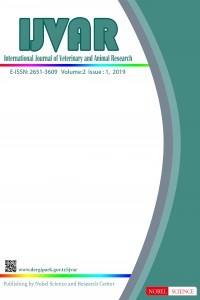The Independent Spirit of Turkey: Wild Horse
Horse, Wild horse, Wildlife
___
- Anonim. 2003. Horse Managment Plan for the Alpine Area of Kosciuszko National Park. NSW National Parks and Wildlife Service. ISBN: 0731366557. Available at: https://www.environment.nsw.gov.au/resources/parks/ kosciuszkoWildHorseManagementPlan.pdf.
- Anonim. 2006. Guy Fawkes River National Park. Horse Management Plan. Department of Environment and Conservation NSW. ISBN: 1-74137-976-8. Available at: http://www.environment.nsw.gov.au/ media/219FE0A15617451894FBC31237BC5920.ashx.
- Anonim. 2007. Draft Feral Horse Management Plan For Barmah Forest. Department of Sustainability and Environmental and Park Victoria.
- Anonim. 2007. Namadgi National Park Feral Horse Management Plan 2007. Feral Horse Damage Parks, Conservation and Lands. Available at: https://www. Environment.act.gov.au/data/assets/pdf_file/0010/901954/ NNP_Feral_Horse_Mgt_Plan_2007.pdf.
- Anonim. 2010. Wild Horses and Burros Management Handbook. United States Department of the Interior Bureau of Land Management. Available at: https://www.blm. gov/sites/blm.gov/files/uploads/Media_Library_BLM_ Poicy_H-4700-1.pdf.
- Anonim. 2015. Humaneness of Currernt Brumby Management Options. Australian Brumby Alliance (ABA). Resources Information Sheet-5.1 Available at: http//australianbrumbyalliance.org.au/wp-content/ uploads/2015/12/5.1-Humaneness-Current-Mgmt-options. pdf.
- Anonim. 2018. Protection of the Alpine National ParkFeral Horse Strategic Action Plan 2018-2020. Australian Veterinary Association (AVA). Available at: https://www. ava.com.au/sites/default/files/AVA%20Submission%20 to%20Feral%20Horse%20Strategic%20action%20Plan%20 2015-02-2018_0.pdf.
- Anonim. 2018. Wild Horse Management and Control Methods. Information Sheet 4 of 5. Parks Victoria. Available at: https://pdfs.semanticscholar. org/7436/9bccb3bda8e4212ba0d0189cdffc62af96d0.pdf.
- Anonim. 2018. Wild Horses and the Ecosystem. American Wild Horse Campaign. Available at: https:// americanwildhorsecampaign.org/wild-horses-andecosystem
- Boyd L, Keiper R. 2000. Behavioral Ecology of Feral Horses. In, Mills DS and McDonnell SM (Eds): The Domestic Horse: The Origins, Development and Management of its Behaviour. Cambridge University Press. ISBN-13: 978-0-521-81414-6. ISBN-10: 0-521-81414-6.
- Corcoan D. 2004. Trapping Techniques-Kosciusko National Park. Feral Horse Management. Report of a Workshop. Thredbo NSW, 29-31 March 2004, pp. 48.
- Csurhes S, Paroz G, Markula A. 2009. Pest Animal Risk Assessment Feral Horse: Equus caballus. Queensland Primary Industries and Fisheries. Available at: https://www. daf.qld.gov.au/_data/assets/pdf_file/0004/51961/IPA-FeralHorses-Risk-Assesment.pdf.
- Foster D. 2004. Brumby Running-Victoria. Feral Horse Management. Report of a Workshop. Thredbo NSW, 29-31 March 2004, pp. 56.
- Güleç E. 2006. Karaman Karadağ Yabani Yılkı Atları. Bilgi Müşavirlik ve Mühendislik. ISBN: 978-9756846-31-5.
- Güleç E. 2009. Türkiye’deki Vahşi At Yılkıları. Bilgi Müşavirlik ve Mühendislik. ISBN: 978-975-95931-3-1.
- Hone j. 2006. Density, Damage and Control of Feral Horses. Dawson MJ, Lane C, Saunders G (Eds) Proceedings of the National Feral Horse Management Workshop, Canberra, August 2006. ISBN: 0-9803194-0-4.
- Killian G, Miller LA, Diehl NK, Rhyan J, Thain D. 2004. Evaluation of Three Contraceptive Approaches for Population Control in Wild Horses. Univ. Of Calif., Davis. Pp. 263-268.
- Nesbitt B. 2004. Trapping and Mustering-Guy Fawkes River National Park. Feral Horse Management. Report of a Workshop. Thredbo NSW, 29-31 March 2004, pp. 49.
- Sharp T, Saunders G. 2008. Model Code of Practice fort he Humane Control of Feral Horses. Available at: https://www.pestsmart.org.au/wp-content/uploads/2012/09/ horseCOP2012.pdf
- Yalowizer S. 2003. What About Wild Horses? Available at: http://libertyparkusafd.org/Jefferson/horses/ Wild%20Horses%20on%20Rangeland.htm
- Başlangıç: 2018
- Yayıncı: Nobel Bilim ve Araştırma Merkezi Limited
Sema ÇAKIR, İbrahim CANPOLAT, Beşir ZÖNGÜR
Koyunculuk İşletmelerinde Çiftçi Eğitim İhtiyaçlarının Analizi: Hayvan Refahı Yönetimi
Zehra BOZKURT, Serdar KOÇAK, Özlem GÜCÜYENER HACAN, Koray ÇELİKELOĞLU, Mustafa TEKERLİ, Metin ERDOĞAN
Perikarditis Travmatikalı Sığırlarda Venöz Kan Gaz Ve Asid- Baz Analizlerin Önemi
İnci Nathalie ERDOĞMUŞ SÜER, Neşe KOCABAĞLI
Ratlarda Pars Timpani Perforasyonunda Nar Ekstratının Mast Hücre Sayısına Etkisi
Tuğrul ERTUĞRUL, Şerife TÜTÜNCÜ
In-Situ Transitional Cell Carcinoma of Urinary Bladder in a Cat
Hazal ÖZTÜRK, Evrim EGEDEN, Özlem EGEDEN, Aydın GÜREL
The Independent Spirit of Turkey: Wild Horse
Özlem HACAN, Serdar KOÇAK, Koray ÇELİKELOĞLU, Zehra BOZKURT, Metin ERDOĞAN, Mustafa TEKERLİ
